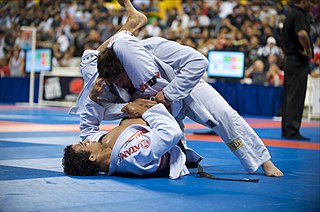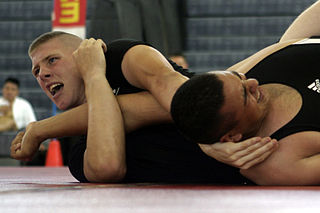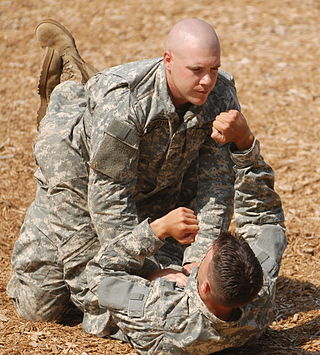
Grappling is a fighting technique based on throws, trips, sweeps, clinch fighting, ground fighting and submission holds.

Brazilian jiu-jitsu is a self-defence martial art and combat sport based on grappling, ground fighting, and submission holds. BJJ focuses on taking ones opponent down to the ground, gaining a dominant position, and using a number of techniques to force them into submission via joint locks or chokeholds.

Submission wrestling, also known as submission grappling, submission fighting or simply grappling, is a competitive martial art and combat sport that focuses on ground fighting and submission techniques. It is a hybrid discipline that incorporates elements of various grappling arts such as various wrestling styles, judo, and Brazilian jiu-jitsu. Submission wrestling is practiced both as a competitive sport and as a training method for self-defence and mixed martial arts (MMA).

Wrestling is a martial art and combat sport that involves grappling with an opponent and striving to obtain a position of advantage through different throws or techniques, within a given ruleset. Wrestling involves different grappling-type techniques such as clinch fighting, throws and takedowns, joint locks, pins, and other grappling holds. Many different wrestling techniques have been incorporated into martial arts, combat sports, and military systems. Wrestling is genuine competition; professional wrestling is athletic theatre.

Greco-Roman, Graeco-Roman, classic wrestling is a style of wrestling that is practiced worldwide. Greco-Roman wrestling was included in the first modern Olympic Games in 1896 and has been in every edition of the summer Olympics held since 1904. This style of wrestling forbids holds below the waist, which is the main feature that differentiates it from freestyle wrestling. This restriction results in an emphasis on throws, because a wrestler cannot use trips to bring an opponent to the ground or hook/grab the opponent's leg to avoid being thrown.

Amateur wrestling is a variant of wrestling practiced at Olympic, collegiate, school, or other amateur level competitions. There are two international wrestling styles performed at the Olympic Games: freestyle and Greco-Roman. Both styles are under the supervision of the United World Wrestling (UWW).

Freestyle wrestling is a style of wrestling. Along with Greco-Roman, it is one of the two styles of wrestling contested in the Olympic Games. USA high school wrestling and men's collegiate wrestling are conducted under different rules and termed scholastic and collegiate wrestling. USA collegiate women's wrestling is conducted under freestyle rules.

The guard is a ground grappling position in which one combatant has their back to the ground while attempting to control the other combatant using their legs. In pure grappling combat sports, the guard is considered an advantageous position, because the bottom combatant can attack with various joint locks and chokeholds, while the top combatant's priority is the transition into a more dominant position, a process known as passing the guard. In the sport of mixed martial arts, as well as hand-to-hand combat in general, it is possible to effectively strike from the top in the guard, even though the bottom combatant exerts some control. There are various types of guard, with their own advantages and disadvantages.
Rumina Sato is a Japanese retired mixed martial artist, famous for his career in the Shooto organization. In the past he fought mostly in the 155 lb division, but he moved down to the 145 lb division.

Scholastic wrestling, commonly referred to as folkstyle wrestling or wrestling, is a style of amateur wrestling practiced at the high school and middle school levels in the United States. It has often been referred to as the "toughest sport in the world" because of the extensive physical conditioning, mental preparation, complexity, and intense nature of its one-on-one competition that requires physical power, speed, quick mental processing and reaction, and enormous preparation.
Tsuyoshi Kosaka is a retired Japanese mixed martial artist, submission grappler and professional wrestler who competed in the Heavyweight division. A professional MMA competitor from 1994 till 2022, he has competed for the UFC, PRIDE Fighting Championships, RIZIN, RINGS, Pancrase, and DEEP. Kosaka is the former King of Pancrase Super Heavyweight Champion.

Clinch fighting or trapping is the part of stand-up fighting where the combatants are grappling in a clinch, typically using clinch holds. Clinching the opponent can be used to eliminate the opponent's effective usage of some kicks, punches, and melee weapons. The clinch can also be used as a medium to switch from stand-up fighting to ground fighting by using takedowns, throws or sweeps.

A grappling hold, commonly referred to simply as a hold that in Japanese is referred to as katame-waza, is any specific grappling, wrestling, judo, or other martial art grip that is applied to an opponent. Grappling holds are used principally to control the opponent and to advance in points or positioning. The holds may be categorized by their function, such as clinching, pinning, or submission, while others can be classified by their anatomical effect: chokehold, headlock, joint-lock, or compression lock. Multiple categories may be appropriate for some of these holds.

A grappling position refers to the positioning and holds of combatants engaged in grappling. Combatants are said to be in a neutral position if neither is in a more favourable position. If one party has a clear advantage such as in the mount they are said to be in a "dominant position". Conversely, the other party is considered to be in an inferior position, usually called "on the bottom", but in this case sometimes called the "under mount".

United World Wrestling (UWW) is the international governing body for the sport of amateur wrestling; its duties include overseeing wrestling at the World Championships and Olympics. It presides over international competitions for various forms of wrestling, including Greco-Roman, Freestyle, Grappling, and others. The flagship event of UWW is the World Wrestling Championships.
Jujutsu techniques include joint locks, chokeholds, strikes, grappling, throwing, and other self-defense techniques.
Most rule sets for mixed martial arts (MMA) competitions have evolved since the early days of Vale Tudo. As a result of health, legal, and moral concerns, many different rulesets were created, which give different countries and promotions very different tactics and strategies. Similarly, shoot wrestling organizations, such as Shooto, expanded their rulesets to integrate elements of Vale Tudo into their sport. However, for the most part, fighters accustomed to one rule set can easily acclimate to the others.
Marcello Salazar M. Bergo is a Brazilian former mixed martial artist. He is a member of the Brazilian Top Team, and is currently a full-time instructor at Brazilian Top Team-Jacksonville in Jacksonville, Florida.

Mats Nilsson is a Swedish grappler and retired mixed martial artist. Nilsson formerly competed in the Welterweight division of the Ultimate Fighting Championship. He is the three time FILA Grappling world champion in the -90 kg no-gi and -92 kg no-gi division and a two-time bronze medalist in FILA Grappling European Championship. Nilsson holds a black belt in both Judo and Brazilian jiu-jitsu. He is currently fighting out of Rumble Sports, Copenhagen, Denmark, while representing Kaisho Martial Arts, Helsingborg, Sweden in grappling.

Kyle Frederick Snyder is an American freestyle wrestler and graduated folkstyle wrestler who competes at 97 kilograms. He holds the distinctions of being the youngest Olympic Gold medalist and the youngest World Champion in American wrestling history.














